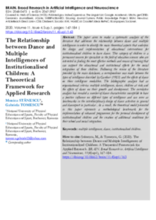Abstract: The paper aims to make a systematic analysis of the literature that addresses the relationship between dance and multiple intelligences in order to identify the main theoretical aspects that underpin the design and implementation of educational interventions for institutionalised children to learn dance. This category of children is a permanent concern for specialists in the field of education sciences who are interested in finding the most effective methods and means of training that can support the educational and institutional efforts for the social integration of these children. Following the review of the literature provided by the main databases, a correspondence was made between the types of intelligence described by Gardner (1983) and the effects of dance on these intelligence modalities. The bibliographic analysis had as organisational criteria: multiple intelligences, dance, children at risk and the effects of dance on their growth and development. The correlative analysis has revealed a number of dance characteristics susceptible to have a positive influence on different types of intelligence and can serve as benchmarks in the interdisciplinary design of dance activities in general and dancesport in particular. As a result, the theoretical model presented in this paper represents a methodological benchmark for the implementation of enhanced programmes for the personal development of institutionalised children and the creation of additional conditions for their school and social integration.

